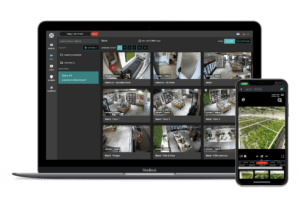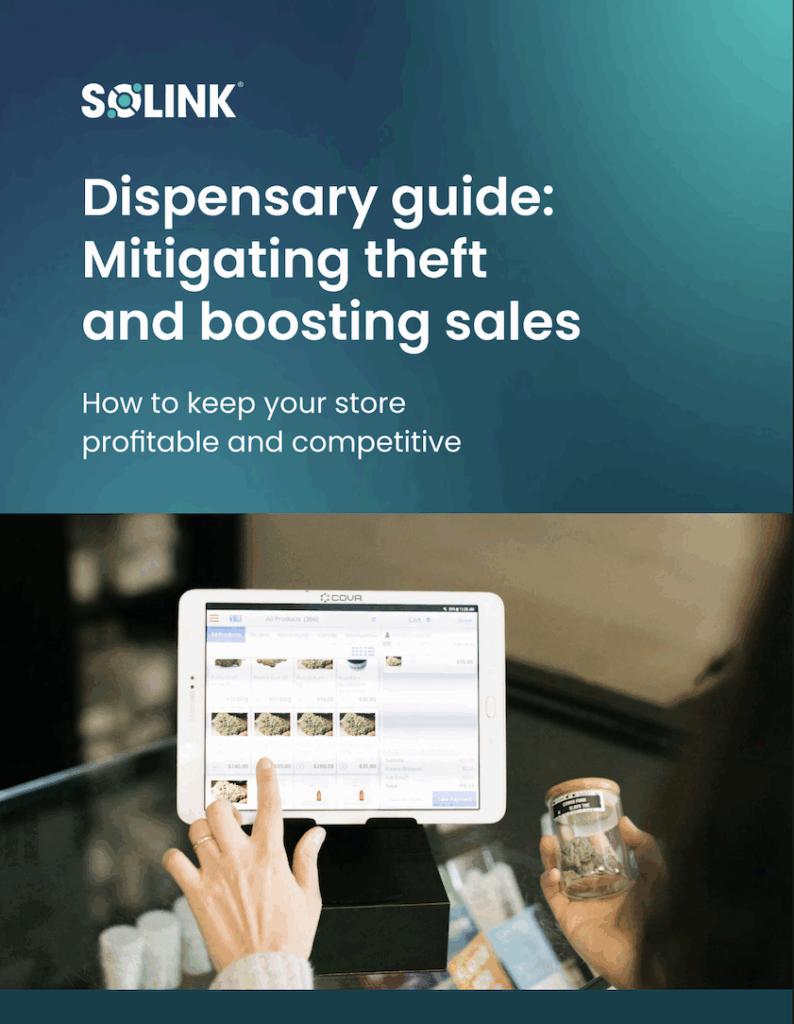Cannabis is a highly regulated industry. Many jurisdictions require new dispensaries or cultivators to have a security plan before issuing a license.
Cannabis has a high price to weight ratio and can be easily sold, which makes it a prime target for both shoplifters and employee theft. In this article, we give you valuable information to consider when looking to develop a cannabis security plan for a dispensary or a cultivator.
This article is part of Solink’s ongoing series on cannabis security.
What do regulators want to see as part of a cannabis security plan?
 When regulatory agencies request a cannabis security plan as part of the pre-licensing process, they have two key items in mind. First, they want to see your security diagrams. These are floor plans of your establishment that indicate all alarms, commercial security cameras, sensors, doors and windows, lights, and so on.
When regulatory agencies request a cannabis security plan as part of the pre-licensing process, they have two key items in mind. First, they want to see your security diagrams. These are floor plans of your establishment that indicate all alarms, commercial security cameras, sensors, doors and windows, lights, and so on.
Second, they want to have a narrative explanation of the security measures in place. This description highlights everything in your security diagram as well as the processes you attach to the equipment.
The specifics of these requirements are constantly changing. Consider heading to a cannabis event near you to hear about all the latest developments.
Cannabis security regulations
Countries, states, and even cities and counties have their own regulations for cannabis cultivators and dispensaries. You’ll need to familiarize yourself with the local regulatory landscape where you plan to operate. However, it is also worth understanding the regulations in other jurisdictions. Since regulations are rapidly evolving, knowing what is happening elsewhere can help you anticipate what changes might be coming.
In particular, for video security, many places have specific requirements for the minimum camera resolution, number of frames captured per second, and length of time you need to store footage.
Whether you need 30 days or several years of video storage, Solink can help you meet your regulatory requirements.
Cannabis security best practices
Before we discuss specific requirements for a cannabis dispensary security plan or cannabis cultivator security plan, let’s look at some cannabis security best practices. Afterall, cannabis security regulations represent the minimally required security practices to be licensed and not what is going to work best for your business.
Following these best practices with the help of Solink will give you peace of mind.
Extra locks on storage space
Placing inventory that is not currently in display cases in a locked storage room is generally a requirement for your cannabis security plan to be approved. Not all employees require access to this room, so separate control measures will help reduce losses due to internal theft as well.

Video security
Video security cameras, as well as a software platform to monitor them 24/7, are a requirement for your cannabis license. However, choosing the integrated video analytics platform offered by Solink will improve every aspect of your business.
Intrusion alarms
 Whether you go with standard sensors or add in Solink’s Video Alarms, you’ll need a way to know when someone is trying to enter your premises outside of working hours. An interesting added benefit of Solink is that you can use our motion search feature during the day to see whether shipments are arriving or leaving outside of designated times, employees are entering break rooms or your office, and monitor people when they enter the storage room.
Whether you go with standard sensors or add in Solink’s Video Alarms, you’ll need a way to know when someone is trying to enter your premises outside of working hours. An interesting added benefit of Solink is that you can use our motion search feature during the day to see whether shipments are arriving or leaving outside of designated times, employees are entering break rooms or your office, and monitor people when they enter the storage room.
All of this can be done on your mobile device from anywhere.
Background checks
Some jurisdictions require all employees in the cannabis industry to pass background checks. Background checks focused on uncovering prior convictions can provide valuable warning for employers working to avoid these common issues. Wherever possible, it is worth taking the time to properly vetting employees to reduce the risk of employee theft, among other problems.
Integrating all equipment
 Most theft in the cannabis industry is internal. One type of employee theft is discount abuse. This, along with cash returns and several other point-of-sale (POS) manipulations, can be found and prevented by integrating your video and POS systems. Solink will show you videos of all transactions with discounts or voids so you can see what is happening. You can even set up real-time alerts to be notified when certain events occur, and they’ll be sent to your smartphone wherever you are.
Most theft in the cannabis industry is internal. One type of employee theft is discount abuse. This, along with cash returns and several other point-of-sale (POS) manipulations, can be found and prevented by integrating your video and POS systems. Solink will show you videos of all transactions with discounts or voids so you can see what is happening. You can even set up real-time alerts to be notified when certain events occur, and they’ll be sent to your smartphone wherever you are.
Policies and procedures
In your cannabis security plan, regulators are looking for both security diagrams and a narrative explanation of what the different components of your security system do and how you are going to use them. Security cameras are a great theft deterrent, until your employees realize you aren’t spending hours sifting through the recordings to find unusual activity. This is where Solink adds a lot of value to your business. We remove all the tedious effort required to find the video clips you need.

Creating a cannabis dispensary security plan
A dispensary security plan is a primary requirement to obtain your state or provincial license to operate. However, understanding why each component is necessary will help you use the security plan to optimize your day-to-day operations. This will save you time and money and lead to a better customer experience.
Here are some of the components you will need to include in your cannabis dispensary security plan.
Locks and alarm systems
 Different regulators have specific requirements for locks and alarms. Most will require alarms on doors that are monitored 24/7. Some will require these alarms to automatically notify the police upon intrusion.
Different regulators have specific requirements for locks and alarms. Most will require alarms on doors that are monitored 24/7. Some will require these alarms to automatically notify the police upon intrusion.
All locks on external doors, as well as those on storage facilities, will probably need to be commercial grade, and most regulators will ask for the brands and model numbers to be included in your cannabis dispensary security plan. You may also need to include the name of the company installing the security and proof they are licensed installers.
Along with locks and alarms on all doors, some states require smash alarms on windows. Some will also require you to install panic buttons and silent alarms in the case of robbery.
Security systems
There are a lot of different types of cloud video security cameras. It is difficult to know which ones will work best for your space. We recently described the different types of cameras for a restaurant use case.
State requirements differ on the resolution and frames per second required for the cameras. You’ll need to make sure that your cameras meet these requirements and list the brands and models in your cannabis dispensary security plan.
Whether you need video storage on premise, in the cloud, or both will be defined by local regulations. The required duration for storage of video footage will also be specified. This ranges widely, currently from 14 days to 4 years depending on the state or province. Manually backing up video footage is time consuming. That’s why Canada Buds uses Solink to do it all manually.
You will likely require camera coverage of every entrance, the POS, and anywhere there is cash or product—basically the entire floor plan except the washroom.
Finally, you’ll need to show on your security diagram where your physical NVR or DVR is located with proof that it is behind a lock. The data must also be secure. Regulators will want to see who has access to the footage and whether you use advanced security measures such as two-factor authentication (2FA).
Solink is equipment-agnostic, which means it can provide the same high-quality video analytics whatever cameras, POS, and inventory management equipment and software you choose. Sign up for a free demo today to see how we can help you save time and money.
Delivery and transportation security
Transporting and delivering cannabis products can be risky. This is true both for products on their way to the dispensary from suppliers and for products being delivered to customers, if you offer such services. If you accept cash, these concerns also apply to the transportation of cash to the bank or cash residing in a delivery vehicle until it returns to the store.
Regulatory requirements can include any of the following:
- Detailed logs of all deliveries
- GPS tracking equipment installed in the vehicle
- Specific times of day when deliveries take place
- At least two staff members in the delivery vehicle
- Cameras facing inside and outside the delivery vehicle
- Using unmarked, company-owned vehicles for deliveries
- Cash and cannabis stored in locked boxes during transportation
- Deliveries only operating through the back, non-customer-facing door
Access control
The rules regarding access control vary depending on the state or province. Some locations will require you to detail how you will check the age of new patrons before they enter your establishment and verify their identity.
Some jurisdictions might require you to have a limit on the number of patrons allowed in the shop at any one time and how you will manage the line outside. This will likely require a door person, which leads to the next potential requirement.
Security guards
Some states require security guards to be present at all cannabis dispensaries. They may or may not be required to be in uniform and/or armed.
Restricted access areas
 A cannabis dispensary has several different areas. Each area needs to be accessible to different people. Customers need access to the storefront but not the backroom. Vendors may need access to the backroom when doing deliveries, but not to the manager’s office. Employees need to have access to the storefront and backroom. However, not all of them need to be given access to your secured storage areas or the manager’s office.
A cannabis dispensary has several different areas. Each area needs to be accessible to different people. Customers need access to the storefront but not the backroom. Vendors may need access to the backroom when doing deliveries, but not to the manager’s office. Employees need to have access to the storefront and backroom. However, not all of them need to be given access to your secured storage areas or the manager’s office.
Your cannabis dispensary security plan should detail who has access to what areas, how the areas are restricted, and how access is managed. For example, it may be that you allow vendors access to the backroom during deliveries, but deliveries only occur during certain times and a manager needs to be present during deliveries. These details will improve your cannabis security plan.
Security training
Your security is only as strong as the weakest link. That weakest link is often your employees’ ability or willingness to follow the security procedures you’ve put in place.
Having a logical set of security procedures will make it easier for your employees to follow the rules. It will also make them more inclined to do so. However, without proper training, testing, and ongoing retraining, your employees may not follow the rules you’ve set in place.
Your procedures should include everything from what to do if you suspect a coworker is stealing to how to deal with an armed robbery. Your training should include practicing these events. Be sure to also provide signage that shows these procedures in action so that employees remain vigilant.

Creating a cannabis cultivator security plan
Cannabis cultivation has many specific security requirements. These sites are often on large plots of land that need to be fenced and secured. In addition to the greenhouses, many have extraction facilities, warehouses, and shipping facilities.
All of these areas have different security needs, as well as general environmental ones. When developing your cannabis cultivator security plan, you’ll want to tie the existing sensors, monitors, cameras, and other equipment together as much as possible to maximize the value they add.
Here are some items that all cannabis cultivator security plans will need to include.
Video security
Many of the points mentioned above for cannabis dispensaries apply to cannabis cultivators as well. However, the specific issues faced by cannabis cultivators are different from those of dispensaries.
While dispensaries are usually found in towns and cities, many cultivators are in more rural settings. The cloud video security needs in a rural environment are different. Regulators may require your business to have a fence constructed around your property with cameras showing all fence lines.
If the driveway requires a gate, then you’ll need cameras at the gate recording vehicles as they enter and exit. You may require other outdoor cameras as well for the parking lot and entrances to your facilities.
Once inside, the entire footprint is likely going to require camera coverage, as regulators generally require all cannabis products and equipment to be visible by cameras.

Using Solink’s video analytics can even benefit the actual growing conditions.
One client recently spoke about issues with a back corner having lower yields than the rest of the grow house. Every time they went to measure the local conditions, they were the same as the rest of the greenhouse. It wasn’t until they used Solink’s motion search that they realized the issue.
Employees were cutting through the greenhouse on the way to the parking lot. Every time they opened the door there was a sudden blast of winter air coming in and affecting the nearest plants. A quick meeting with the staff explaining the problem improved the bottom line.

Intrusion detection
Intrusion detection is directly related to access control. Alarm systems generally need to be monitored 24/7 in case of intruders so that emergency services can be dispatched immediately.
However, the flip side of this is false alarms. For example, in rural areas, curious wildlife can set off alarms. These false alarms can cost the cultivator a lot of money. Solink’s Video Alarms prevent false alarms by making it possible to review alarms in real-time from anywhere and confirm whether police need to be dispatched.
Access control
Access control for a cannabis cultivator begins at the property edge. Fences and a security gate are generally part of the required cannabis cultivator security plan. The buildings usually need to be locked at all times and require an access code and/or badge to enter.
There are usually requirements for further access control, including alarm systems, during non-working hours. Some jurisdictions also require security guards to be present at all times.

Conclusion
Cannabis dispensaries and cultivators are at particularly high risk for theft, both employee theft and robberies. The product is light, expensive, and easy to sell. The amount of cash flowing through some of these establishments also makes them enticing targets for thieves.
Creating a cannabis security plan can be a significant part of the licensing process. However, you should take the time to get it right as having a regulation-exceeding security system will save you money in the long run.

